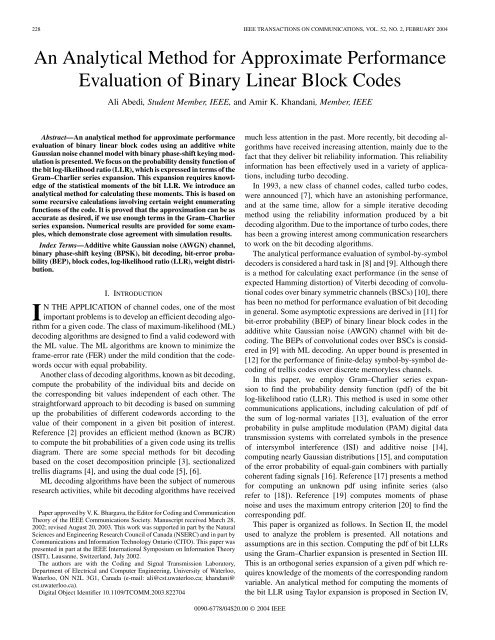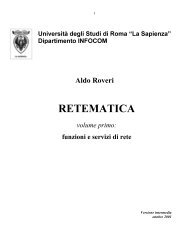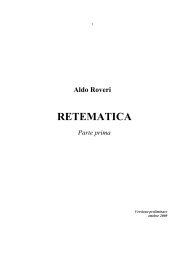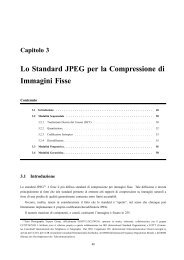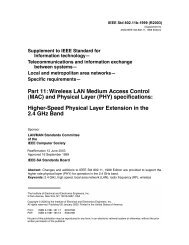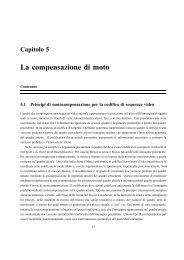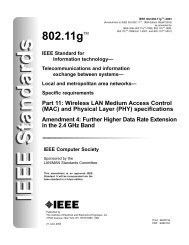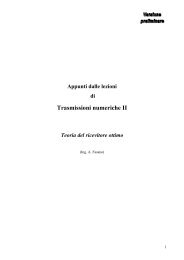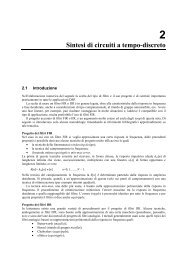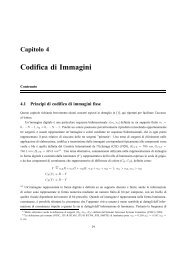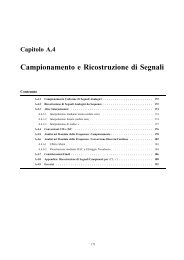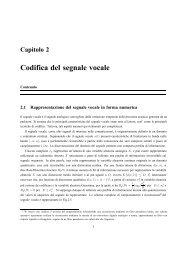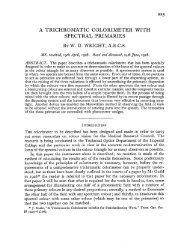An Analytical Method for Approximate Performance ... - IEEE Xplore
An Analytical Method for Approximate Performance ... - IEEE Xplore
An Analytical Method for Approximate Performance ... - IEEE Xplore
Create successful ePaper yourself
Turn your PDF publications into a flip-book with our unique Google optimized e-Paper software.
228 <strong>IEEE</strong> TRANSACTIONS ON COMMUNICATIONS, VOL. 52, NO. 2, FEBRUARY 2004<br />
<strong>An</strong> <strong>An</strong>alytical <strong>Method</strong> <strong>for</strong> <strong>Approximate</strong> Per<strong>for</strong>mance<br />
Evaluation of Binary Linear Block Codes<br />
Ali Abedi, Student Member, <strong>IEEE</strong>, and Amir K. Khandani, Member, <strong>IEEE</strong><br />
Abstract—<strong>An</strong> analytical method <strong>for</strong> approximate per<strong>for</strong>mance<br />
evaluation of binary linear block codes using an additive white<br />
Gaussian noise channel model with binary phase-shift keying modulation<br />
is presented. We focus on the probability density function of<br />
the bit log-likelihood ratio (LLR), which is expressed in terms of the<br />
Gram–Charlier series expansion. This expansion requires knowledge<br />
of the statistical moments of the bit LLR. We introduce an<br />
analytical method <strong>for</strong> calculating these moments. This is based on<br />
some recursive calculations involving certain weight enumerating<br />
functions of the code. It is proved that the approximation can be as<br />
accurate as desired, if we use enough terms in the Gram–Charlier<br />
series expansion. Numerical results are provided <strong>for</strong> some examples,<br />
which demonstrate close agreement with simulation results.<br />
Index Terms—Additive white Gaussian noise (AWGN) channel,<br />
binary phase-shift keying (BPSK), bit decoding, bit-error probability<br />
(BEP), block codes, log-likelihood ratio (LLR), weight distribution.<br />
I. INTRODUCTION<br />
IN THE APPLICATION of channel codes, one of the most<br />
important problems is to develop an efficient decoding algorithm<br />
<strong>for</strong> a given code. The class of maximum-likelihood (ML)<br />
decoding algorithms are designed to find a valid codeword with<br />
the ML value. The ML algorithms are known to minimize the<br />
frame-error rate (FER) under the mild condition that the codewords<br />
occur with equal probability.<br />
<strong>An</strong>other class of decoding algorithms, known as bit decoding,<br />
compute the probability of the individual bits and decide on<br />
the corresponding bit values independent of each other. The<br />
straight<strong>for</strong>ward approach to bit decoding is based on summing<br />
up the probabilities of different codewords according to the<br />
value of their component in a given bit position of interest.<br />
Reference [2] provides an efficient method (known as BCJR)<br />
to compute the bit probabilities of a given code using its trellis<br />
diagram. There are some special methods <strong>for</strong> bit decoding<br />
based on the coset decomposition principle [3], sectionalized<br />
trellis diagrams [4], and using the dual code [5], [6].<br />
ML decoding algorithms have been the subject of numerous<br />
research activities, while bit decoding algorithms have received<br />
Paper approved by V. K. Bhargava, the Editor <strong>for</strong> Coding and Communication<br />
Theory of the <strong>IEEE</strong> Communications Society. Manuscript received March 28,<br />
2002; revised August 20, 2003. This work was supported in part by the Natural<br />
Sciences and Engineering Research Council of Canada (NSERC) and in part by<br />
Communications and In<strong>for</strong>mation Technology Ontario (CITO). This paper was<br />
presented in part at the <strong>IEEE</strong> International Symposium on In<strong>for</strong>mation Theory<br />
(ISIT), Lausanne, Switzerland, July 2002.<br />
The authors are with the Coding and Signal Transmission Laboratory,<br />
Department of Electrical and Computer Engineering, University of Waterloo,<br />
Waterloo, ON N2L 3G1, Canada (e-mail: ali@cst.uwaterloo.ca; khandani@<br />
cst.uwaterloo.ca).<br />
Digital Object Identifier 10.1109/TCOMM.2003.822704<br />
0090-6778/04$20.00 © 2004 <strong>IEEE</strong><br />
much less attention in the past. More recently, bit decoding algorithms<br />
have received increasing attention, mainly due to the<br />
fact that they deliver bit reliability in<strong>for</strong>mation. This reliability<br />
in<strong>for</strong>mation has been effectively used in a variety of applications,<br />
including turbo decoding.<br />
In 1993, a new class of channel codes, called turbo codes,<br />
were announced [7], which have an astonishing per<strong>for</strong>mance,<br />
and at the same time, allow <strong>for</strong> a simple iterative decoding<br />
method using the reliability in<strong>for</strong>mation produced by a bit<br />
decoding algorithm. Due to the importance of turbo codes, there<br />
has been a growing interest among communication researchers<br />
to work on the bit decoding algorithms.<br />
The analytical per<strong>for</strong>mance evaluation of symbol-by-symbol<br />
decoders is considered a hard task in [8] and [9]. Although there<br />
is a method <strong>for</strong> calculating exact per<strong>for</strong>mance (in the sense of<br />
expected Hamming distortion) of Viterbi decoding of convolutional<br />
codes over binary symmetric channels (BSCs) [10], there<br />
has been no method <strong>for</strong> per<strong>for</strong>mance evaluation of bit decoding<br />
in general. Some asymptotic expressions are derived in [11] <strong>for</strong><br />
bit-error probability (BEP) of binary linear block codes in the<br />
additive white Gaussian noise (AWGN) channel with bit decoding.<br />
The BEPs of convolutional codes over BSCs is considered<br />
in [9] with ML decoding. <strong>An</strong> upper bound is presented in<br />
[12] <strong>for</strong> the per<strong>for</strong>mance of finite-delay symbol-by-symbol decoding<br />
of trellis codes over discrete memoryless channels.<br />
In this paper, we employ Gram–Charlier series expansion<br />
to find the probability density function (pdf) of the bit<br />
log-likelihood ratio (LLR). This method is used in some other<br />
communications applications, including calculation of pdf of<br />
the sum of log-normal variates [13], evaluation of the error<br />
probability in pulse amplitude modulation (PAM) digital data<br />
transmission systems with correlated symbols in the presence<br />
of intersymbol interference (ISI) and additive noise [14],<br />
computing nearly Gaussian distributions [15], and computation<br />
of the error probability of equal-gain combiners with partially<br />
coherent fading signals [16]. Reference [17] presents a method<br />
<strong>for</strong> computing an unknown pdf using infinite series (also<br />
refer to [18]). Reference [19] computes moments of phase<br />
noise and uses the maximum entropy criterion [20] to find the<br />
corresponding pdf.<br />
This paper is organized as follows. In Section II, the model<br />
used to analyze the problem is presented. All notations and<br />
assumptions are in this section. Computing the pdf of bit LLRs<br />
using the Gram–Charlier expansion is presented in Section III.<br />
This is an orthogonal series expansion of a given pdf which requires<br />
knowledge of the moments of the corresponding random<br />
variable. <strong>An</strong> analytical method <strong>for</strong> computing the moments of<br />
the bit LLR using Taylor expansion is proposed in Section IV,
ABEDI AND KHANDANI: ANALYTICAL METHOD FOR APPROXIMATE PERFORMANCE EVALUATION OF BINARY LINEAR BLOCK CODES 229<br />
where it is shown that we can compute the coefficients of<br />
Taylor expansion of the bit LLR recursively. We also present a<br />
closed-<strong>for</strong>m expression <strong>for</strong> computing the BEP in Section V.<br />
In Section VI, the convergence issue of this approximation<br />
is discussed. Numerical results are provided in Section VII,<br />
which demonstrate a close agreement between our analytical<br />
method and simulation. We conclude in Section VIII.<br />
II. MODELING<br />
Assume that a binary linear code with codewords of length<br />
is given. We use notation to refer to a<br />
codeword and its elements. We partition the code into a subcode<br />
and its coset according to the value of the th bit position<br />
of its codewords, i.e.,<br />
We define the following operators on the code book:<br />
(1)<br />
(2)<br />
Bitwise binary addition of two codewords (3)<br />
Note that the subcode is closed under binary addition.<br />
The dot product of two vectors and<br />
is defined as<br />
The modulation scheme used here is binary phase-shift<br />
keying (BPSK), which is defined as the mapping<br />
(4)<br />
(5)<br />
(6)<br />
Note that modulating a codeword as mentioned above results<br />
in a vector of constant square norm<br />
We use the notation to refer to the Hamming weight of a<br />
codeword , which is equal to the number of ones in . It follows<br />
that:<br />
Modulating a codeword using BPSK<br />
and sending it through an AWGN channel, we will receive<br />
, where is an independent,<br />
identically distributed (i.i.d.) Gaussian noise vector which has<br />
zero-mean elements of variance . Note that <strong>for</strong> an AWGN<br />
channel, we have<br />
(7)<br />
(8)<br />
(9)<br />
A common tool to express the bit probabilities in bit decoding<br />
algorithms is based on using the so-called LLR. The LLR of the<br />
th bit position is defined by the following equation:<br />
(10)<br />
where is the value of the th bit in the transmitted codeword<br />
and log stands <strong>for</strong> the natural logarithm. Assuming<br />
and using (9), it follows:<br />
Using (7), it follows:<br />
(11)<br />
(12)<br />
(13)<br />
(14)<br />
(15)<br />
Given a value of the bit LLR, a decision on the value of bit<br />
is made by comparing LLR with a threshold of zero. We are<br />
interested in studying the probabilistic behavior of LLR as a<br />
function of the Gaussian random vector .<br />
Using the following theorems from [21], 1 we can simplify<br />
our analysis.<br />
Theorem 1: The probability distribution of LLR is not<br />
affected by the choice of transmitted codeword , as long as the<br />
value of the th bit remains unchanged.<br />
Theorem 2: The probability distribution of LLR <strong>for</strong><br />
0 or 1 are the reflections of one another through the origin.<br />
Theorem 3: The probability distribution of LLR is not<br />
affected by the choice of bit position , <strong>for</strong> the class of Cyclic<br />
codes.<br />
Using Theorems 1 and 2, without loss of generality, we assume<br />
<strong>for</strong> convenience that the all-zero codeword, denoted as<br />
, is transmitted in all our following discussions.<br />
This means is the transmitted<br />
modulated codeword.<br />
In this case, (15) reduces to<br />
(16)<br />
1 For the sake of brevity, the proofs are not given here. The reader is referred<br />
to [21] <strong>for</strong> proofs.
230 <strong>IEEE</strong> TRANSACTIONS ON COMMUNICATIONS, VOL. 52, NO. 2, FEBRUARY 2004<br />
Using (8), we obtain<br />
(17)<br />
In the following, <strong>for</strong> convenience of notation, the index indicating<br />
bit position is dropped. This means the sets and<br />
are indeed and , respectively. We use the notation<br />
to refer to the LLR expression given in (17), i.e.,<br />
III. GRAM–CHARLIER EXPANSION OF PDF<br />
(18)<br />
One common method <strong>for</strong> representing a function is to use<br />
an expansion on an orthogonal basis which is suitable <strong>for</strong> that<br />
function. As the pdf of a bit LLR is approximately Gaussian<br />
[7], [22], [23], the appropriate basis can be a normal Gaussian<br />
pdf and its derivatives which <strong>for</strong>m an orthogonal basis. There<br />
are a variety of equivalent <strong>for</strong>mulations <strong>for</strong> this expansion [15],<br />
[24]–[26]. We follow the notation used in [15].<br />
Consider a random variable , which is normalized to have<br />
zero mean and unit variance. One can expand the pdf of ,<br />
namely , using the following <strong>for</strong>mula, which is called the<br />
Gram–Charlier series expansion:<br />
(19)<br />
where is the Hermite polynomial [15] of order , defined<br />
as<br />
and has the following closed <strong>for</strong>m:<br />
where<br />
(20)<br />
(21)<br />
(22)<br />
(23)<br />
This is a commonly used method <strong>for</strong> approximating an unknown<br />
pdf. The only unknown components in (22) are the moments,<br />
. We propose an analytical method using Taylor series expansion<br />
to compute the moments of the bit LLR in the next section.<br />
IV. COMPUTING MOMENTS USING<br />
TAYLOR EXPANSION OF LLR<br />
Applying the definition of the<br />
bit LLR results in<br />
th order moment to<br />
(24)<br />
(25)<br />
where stands <strong>for</strong> expectation and denotes variance.<br />
Note that to compute (25), one needs , .<br />
To compute , we take advantage of a method similar<br />
to the so-called Delta method [27] and find the average of<br />
the Taylor series expansion of . We use the Taylor series<br />
expansion of in conjunction with the polynomial theorem<br />
[15] to find an expansion <strong>for</strong><br />
(26)<br />
where is the gradient of at . <strong>An</strong> alternative<br />
approach is to directly expand . Note that derivatives of<br />
are functions of derivatives of .<br />
The Taylor series expansion of around vector zero,<br />
, is <strong>for</strong>mulated using the expression below in terms<br />
of<br />
(27)<br />
(28)<br />
We can continue with calculation of different terms in the<br />
above equation. For simplicity, we define (18) as<br />
, where<br />
(29)<br />
and has a similar <strong>for</strong>mula. We only consider<br />
hereafter in this section. The same approach can be used <strong>for</strong><br />
. For simplicity of notation, we use instead of<br />
(30)
ABEDI AND KHANDANI: ANALYTICAL METHOD FOR APPROXIMATE PERFORMANCE EVALUATION OF BINARY LINEAR BLOCK CODES 231<br />
To simplify the subsequent derivations, the following functions<br />
are defined:<br />
(31)<br />
where is a set which contains bit positions different<br />
from , and<br />
where is the modulated value <strong>for</strong> the th,<br />
, bit of codeword . It is clear that<br />
, as well.<br />
To simplify (30), it easily follows that:<br />
where is defined as<br />
(32)<br />
(33)<br />
(34)<br />
where and are given in (29) and (31), respectively.<br />
The functions , , and ,<br />
defined in (29), (31), and (34), respectively, reduce to special<br />
weight distribution functions when<br />
(35)<br />
where , and is the number of codewords<br />
with Hamming weight in<br />
(36)<br />
where is the number of codewords with<br />
Hamming weight , and<br />
(37)<br />
We can compute , using the trellis diagram of the<br />
code. This is achieved by constructing a new trellis diagram and<br />
augmenting each state into two states according to the values of<br />
, where .<br />
Using (33) and (37), we have<br />
(38)<br />
Replacing (33) and (38) in (30), we have<br />
(39)<br />
To compute (39), one needs derivatives of , which<br />
can be calculated using the following theorem.<br />
Theorem 4: For any representing a bit position other than<br />
,wehave<br />
if<br />
otherwise.<br />
(40)<br />
Proof: For proof, refer to Appendix A.<br />
<strong>An</strong>other theorem which simplifies the calculation of even<br />
order derivatives, is presented next.<br />
Theorem 5: We have<br />
(41)<br />
Proof: For proof, refer to Appendix A.<br />
Referring to (40), one can easily see that the coefficients of the<br />
expansion (39) are polynomials of <strong>for</strong> different<br />
values of . It is noteworthy that these coefficients are polynomials<br />
of special weight distribution functions defined in (37).<br />
The above theorems and results enable us to compute all the<br />
derivatives required in the Taylor series expansion of<br />
.<br />
V. COMPUTING PROBABILITY OF ERROR<br />
The BEP follows by a simple integration of the resulting pdf.<br />
We present a closed-<strong>for</strong>m <strong>for</strong>mula <strong>for</strong> computing this integral in<br />
this section.<br />
Using Theorem 2, wehave<br />
where event corresponds to bit<br />
(42)<br />
being in error. Using assumption<br />
(11), we can write<br />
(43)<br />
Hence, computation of the BEP involves calculating an integral<br />
of the following <strong>for</strong>m:<br />
(44)<br />
where is the bit LLR normalized to have zero mean and<br />
unit variance and . Substituting with its<br />
Gram–Charlier expansion results in<br />
(45)
232 <strong>IEEE</strong> TRANSACTIONS ON COMMUNICATIONS, VOL. 52, NO. 2, FEBRUARY 2004<br />
Noting that , ,wehave<br />
(46)<br />
(47)<br />
Changing the order of integration and summation and using<br />
the following property: 2<br />
we can write<br />
(48)<br />
(49)<br />
(50)<br />
(51)<br />
This results in a closed-<strong>for</strong>m expression <strong>for</strong> computing probability<br />
of error.<br />
VI. CONVERGENCE PROPERTIES<br />
Convergence properties of the Gram–Charlier expansion is<br />
investigated in [24], [28], and [29]. It is proved in [30] that the<br />
expansion is convergent if the expanded function satisfies the<br />
following condition:<br />
(52)<br />
Reference [13] mentions that this expansion has good asymptotic<br />
behavior as defined in [31]. In other words, a few terms<br />
will give a close approximation.<br />
General properties of Hermite polynomials are discussed in<br />
[32], where it is shown that this class of polynomials <strong>for</strong>m an<br />
orthogonal basis which span the interval ( , ). There<strong>for</strong>e,<br />
the pdf of the bit LLR can be expanded arbitrarily closely, in a<br />
mean-square sense, using the given set of orthogonal basis, i.e.,<br />
where is truncation error defined as<br />
(53)<br />
(54)<br />
If is piecewise continuous in the interval ( ,<br />
), the result of this expansion converges to at each<br />
point of ( , ) at which is continuous. At points<br />
where has a jump discontinuity, this series converges to<br />
2 Proof is in Appendix B.<br />
Fig. 1. Comparison between analytical and experimental BER <strong>for</strong> (15,11,3)<br />
Cyclic code.<br />
[33]. In the following, we show that the<br />
error in the computation of BEP converges to zero.<br />
In practice, computation of error probability is per<strong>for</strong>med by<br />
integrating from to instead of to , where<br />
and is a large finite value.<br />
Using the Cauchy–Schwartz inequality [34]<br />
<strong>for</strong> the case of , and<br />
we have<br />
Applying (53)to (57) results in<br />
otherwise<br />
(55)<br />
(56)<br />
(57)<br />
(58)<br />
In this case, we can get as small as the desired error in<br />
computation of the error probability by increasing the number<br />
of terms .<br />
VII. NUMERICAL RESULTS<br />
In this section, some examples are provided which show a<br />
close agreement between the analytical method and simulation<br />
results.<br />
As an example, we used a (15, 11, 3) Cyclic code and evaluated<br />
its per<strong>for</strong>mance using the proposed method. The order of<br />
the Gram–Charlier expansion is 10. The comparison between<br />
the analytically calculated bit-error rate (BER) and the one obtained<br />
from simulation is shown in Fig. 1. From Theorem 3,we<br />
know that in the case of Cyclic codes, the computed pdf is not<br />
affected by the choice of the bit position.
ABEDI AND KHANDANI: ANALYTICAL METHOD FOR APPROXIMATE PERFORMANCE EVALUATION OF BINARY LINEAR BLOCK CODES 233<br />
Fig. 2. Comparison between analytical and experimental BER <strong>for</strong> (12,11,2)<br />
single parity-check code.<br />
Fig. 3. Comparison between analytical and experimental BER <strong>for</strong> binary<br />
extended (24,12,8) Golay code.<br />
<strong>An</strong>other example is a (12,11,2) single parity-check code. The<br />
order of the Gram–Charlier expansion is 10. The comparison<br />
between the analytically calculated BER and the one obtained<br />
from simulation is shown in Fig. 2.<br />
The last example is the binary extended (24,12,8) Golay code.<br />
Its per<strong>for</strong>mance is shown in Fig. 3. The BER is calculated using<br />
the Gram–Charlier series with 14 terms.<br />
There is not any known method in the literature to calculate<br />
the truncation error of the Gram–Charlier series. It is an open<br />
problem to determine where to truncate the series to get a good<br />
approximation.<br />
VIII. CONCLUDING REMARKS<br />
A method is presented <strong>for</strong> calculating BEP of binary linear<br />
block codes over an AWGN channel, using special weight enumerating<br />
functions of the code. A summary of the proposed<br />
method is presented here. Starting with calculation of special<br />
weight distribution functions defined in (37), proceed with a<br />
Fig. 4. Flow chart of the analytical method <strong>for</strong> per<strong>for</strong>mance evaluation of<br />
binary linear block codes.<br />
Taylor series of the LLR, as indicated in (27). Averaging this expansion<br />
will give us moments of the pdf of the bit LLR, which<br />
can be used to compute the coefficients of the Gram–Charlier<br />
series using (22). A closed-<strong>for</strong>m expression (51) can be used to<br />
find the BEP. All these steps can be seen in Fig. 4. A possibility<br />
<strong>for</strong> future work is the extension of this method <strong>for</strong> per<strong>for</strong>mance<br />
evaluation of turbo codes. Although calculation of the required<br />
weight distribution functions <strong>for</strong> turbo codes is very complex, it<br />
can be approximated using the concept of uni<strong>for</strong>m interleaving.<br />
Some existing approaches are bounds on the per<strong>for</strong>mance of<br />
turbo codes [35]–[37] under the assumption of ML decoding.<br />
APPENDIX<br />
PROOFS OF THEOREMS<br />
Theorem 4:<br />
Proof: Using (34), one can write<br />
(59)<br />
(60)<br />
(61)<br />
(62)
234 <strong>IEEE</strong> TRANSACTIONS ON COMMUNICATIONS, VOL. 52, NO. 2, FEBRUARY 2004<br />
Using (31) and noting that ,wehave<br />
(63)<br />
(64)<br />
if<br />
otherwise.<br />
(65)<br />
Substituting (65) in (64), and using (34), completes the proof.<br />
Theorem 5:<br />
Proof: We consider two different cases. If<br />
, using (40), one can write<br />
For the other case where ,wehave<br />
(66)<br />
(67)<br />
(68)<br />
(69)<br />
(70)<br />
(71)<br />
(72)<br />
(73)<br />
(74)<br />
(75)<br />
(76)<br />
(77)<br />
It can be seen from (71) and (77) that both cases ended up<br />
with the same expression as the one in (41), which completes<br />
the proof.<br />
PROOF OF PROPERTY (48)<br />
We can expand the right-hand side of (48) as follows:<br />
Using (20), we have<br />
It follows that:<br />
Substituting (82) in (79), we have<br />
which is the left-hand side of (48).<br />
ACKNOWLEDGMENT<br />
(78)<br />
(79)<br />
(80)<br />
(81)<br />
(82)<br />
(83)<br />
The authors would like to thank M. H. Baligh, A. Heunis,<br />
and M. Thompson <strong>for</strong> their helpful discussions and comments.<br />
They also acknowledge the detailed comments of the reviewers<br />
which have been extremely helpful in improving the quality of<br />
this article.
ABEDI AND KHANDANI: ANALYTICAL METHOD FOR APPROXIMATE PERFORMANCE EVALUATION OF BINARY LINEAR BLOCK CODES 235<br />
REFERENCES<br />
[1] A. Abedi and A. K. Khandani, “<strong>An</strong> analytical method <strong>for</strong> per<strong>for</strong>mance<br />
analysis of binary linear block codes,” in Proc. <strong>IEEE</strong> Int. Symp. In<strong>for</strong>mation<br />
Theory, Lausanne, Switzerland, July 2002, p. 403.<br />
[2] L. R. Bahl, J. Cocke, F. Jelinek, and J. Raviv, “Optimal decoding of linear<br />
codes <strong>for</strong> minimizing symbol error rate,” <strong>IEEE</strong> Trans. In<strong>for</strong>m. Theory,<br />
vol. IT-20, pp. 284–287, Mar. 1974.<br />
[3] L. Ping and K. L. Yeung, “Symbol-by-symbol decoding of the Golay<br />
code and iterative decoding of concatenated Golay codes,” <strong>IEEE</strong> Trans.<br />
In<strong>for</strong>m. Theory, vol. 45, pp. 2558–2562, Nov. 1999.<br />
[4] Y. Liu, S. Lin, and M. P. C. Fossorier, “MAP algorithms <strong>for</strong> decoding<br />
linear block codes based on sectionalized trellis diagrams,” <strong>IEEE</strong> Trans.<br />
Commun., vol. 48, pp. 577–586, Apr. 2000.<br />
[5] S. Riedel, “Symbol-by-symbol MAP decoding algorithm <strong>for</strong> high-rate<br />
convolutional codes that use reciprocal dual codes,” <strong>IEEE</strong> J. Select.<br />
Areas Commun., vol. 16, pp. 175–185, Feb. 1998.<br />
[6] C. R. P. Hartmann and L. D. Rudolph, “<strong>An</strong> optimum symbol-by-symbol<br />
decoding rule <strong>for</strong> linear codes,” <strong>IEEE</strong> Trans. In<strong>for</strong>m. Theory, vol. IT-22,<br />
pp. 514–517, Sept. 1976.<br />
[7] C. Berrou, A. Glavieux, and P. Thitimajshima, “Near Shannon limit<br />
error-correcting coding and decoding: turbo codes (1),” in Proc. <strong>IEEE</strong><br />
Int. Conf. Communications, Geneva, Switzerland, May 1993, pp.<br />
1064–1070.<br />
[8] J. G. Proakis, Digital Communication, 2nd ed. New York: McGraw-<br />
Hill, 1989.<br />
[9] S. S. Pietrobon, “On the probability of error of convolutional codes,”<br />
<strong>IEEE</strong> Trans. In<strong>for</strong>m. Theory, vol. 42, pp. 1562–1568, Sept. 1996.<br />
[10] M. R. Best, M. V. Burnashev, Y. Levy, A. Rabinovich, P. C. Fishburn,<br />
A. R. Calderbank, and D. J. Costello, Jr., “On a technique to calculate<br />
the exact per<strong>for</strong>mance of a convolutional code,” <strong>IEEE</strong> Trans. In<strong>for</strong>m.<br />
Theory, vol. 41, pp. 441–447, Mar. 1995.<br />
[11] C. R. P. Hartmann, L. D. Rudolph, and K. G. Mehrotra, “Asymptotic<br />
per<strong>for</strong>mance of optimum bit-by-bit decoding <strong>for</strong> the white Gaussian<br />
channel,” <strong>IEEE</strong> Trans. In<strong>for</strong>m. Theory, vol. IT-23, pp. 520–522, July<br />
1977.<br />
[12] E. Baccarelli, R. Cusani, and G. D. Blasio, “Per<strong>for</strong>mance bound and<br />
trellis-code design criterion <strong>for</strong> discrete memoryless channels and finitedelay<br />
symbol-by-symbol decoding,” <strong>IEEE</strong> Trans. Commun., vol. 45, pp.<br />
1192–1199, Oct. 1997.<br />
[13] D. C. Schleher, “Generalized Gram–Charlier series with application to<br />
the sum of log-normal variates,” <strong>IEEE</strong> Trans. In<strong>for</strong>m. Theory, vol. IT-23,<br />
pp. 275–280, Mar. 1977.<br />
[14] G. L. Cariolaro and S. G. Pupolin, “Considerations on error probability<br />
in correlated-symbol systems,” <strong>IEEE</strong> Trans. Commun., vol. COM-25,<br />
pp. 462–467, Apr. 1977.<br />
[15] S. Blinnikov and R. Moessner, “Expansions <strong>for</strong> nearly Gaussian distributions,”<br />
Astron. Astrophys. Supplement Ser., vol. 130, no. 1, pp. 193–205,<br />
May 1998.<br />
[16] M. A. Najib and V. K. Prabhu, “<strong>An</strong>alysis of equal-gain diversity with<br />
partially coherent fading signals,” <strong>IEEE</strong> Trans. Veh. Technol., vol. 49,<br />
pp. 783–791, May 2000.<br />
[17] N. C. Beaulieu, “<strong>An</strong> infinite series <strong>for</strong> the computation of the complementary<br />
probability distribution of a sum of independent random variables<br />
and its application to the sum of Rayleigh random variables,” <strong>IEEE</strong><br />
Trans. Commun., vol. 38, pp. 1463–1474, Sept. 1990.<br />
[18] C. Tellambura and A. <strong>An</strong>namalai, “Further results on the Beaulieu series,”<br />
<strong>IEEE</strong> Trans. Commun., vol. 48, pp. 1774–1777, Nov. 2000.<br />
[19] I. T. Monroy and G. Hooghiemstra, “On a recursive <strong>for</strong>mula <strong>for</strong> the moments<br />
of phase noise,” <strong>IEEE</strong> Trans. Commun., vol. 48, pp. 917–920,<br />
June 2000.<br />
[20] M. Kavehrad and M. Joseph, “Maximum entropy and the method of moments<br />
in per<strong>for</strong>mance evaluation of digital communications systems,”<br />
<strong>IEEE</strong> Trans. Commun., vol. COM-34, pp. 1183–1189, Dec. 1986.<br />
[21] A. Abedi, P. Chaudhari, and A. K. Khandani, “On some properties of<br />
bit decoding algorithms,” in Proc. Canadian Workshop on In<strong>for</strong>mation<br />
Theory (CWIT 2001), Vancouver, BC, Canada, June 2001, pp. 106–109.<br />
[22] H. El-Gamal and A. R. Hammons, Jr., “<strong>An</strong>alyzing the turbo decoder<br />
using the Gaussian approximation,” <strong>IEEE</strong> Trans. In<strong>for</strong>m. Theory, vol.<br />
47, pp. 671–686, Feb. 2001.<br />
[23] D. Divsalar, S. Dolinar, and F. Pollara, “Iterative turbo decoder analysis<br />
based on density evolution,” <strong>IEEE</strong> J. Select. Areas Commun., vol. 19,<br />
pp. 891–907, May 2001.<br />
[24] R. S. Freedman, “On Gram–Charlier approximations,” <strong>IEEE</strong> Trans.<br />
Commun., vol. COM-29, pp. 122–125, Feb. 1981.<br />
[25] M. Abramowitz, Handbook of Mathematical Functions. Washington,<br />
DC: U.S. Dept. of Commerce, 1958.<br />
[26] J. F. Kenney and E. S. Keeping, Mathematics of Statistics, 2nd<br />
ed. Princeton, NJ: Van Nostrand, 1951, pt. 2.<br />
[27] A. W. Van der vaart, Asymptotic Statistics. Cambridge, U.K.: Cambridge<br />
Univ. Press, 1998.<br />
[28] H. Cramer, Mathematical <strong>Method</strong>s of Statistics. Princeton, NJ:<br />
Princeton Univ. Press, 1957.<br />
[29] , Random Variables and Probability Distributions, 3rd ed. Cambridge,<br />
U.K.: Cambridge Univ. Press, 1970.<br />
[30] , “On some classes of series used in mathematical statistics,” in<br />
Proc. 6th Scandinavian Congr. Mathematicians, Copenhagen, Denmark,<br />
1925, pp. 399–425.<br />
[31] E. T. Whittaker and G. N. Watson, A Course of Modern <strong>An</strong>alysis, 4th<br />
ed. Cambridge, U.K.: Cambridge Univ. Press, 1962.<br />
[32] G. Szego, Orthogonal Polynomials. Providence, RI: RI Amer. Math.<br />
Soc., 1967.<br />
[33] P. V. Oneil, Advanced Engineering Mathematics, 4th ed. New York:<br />
Thomson, 1995.<br />
[34] I. S. Gradshteyn and I. M. Ryzhik, Table of Integrals, Series, and Products,<br />
5th ed. New York: Academic, 1994.<br />
[35] T. M. Duman and M. Salehi, “New per<strong>for</strong>mance bounds <strong>for</strong> turbo<br />
codes,” <strong>IEEE</strong> Trans. Commun., vol. 46, pp. 717–723, June 1998.<br />
[36] D. Divsalar, “A Simple Tight Bound on Error Probability of Block Codes<br />
With Application to Turbo Codes,” NASA, JPL, Pasadena, CA, TMO<br />
Progress Rep. 42-139, 1999.<br />
[37] I. Sason and S. Shamai, “Improved upper bounds on the ML decoding<br />
error probability of parallel and serial concatenated turbo codes via their<br />
ensemble distance spectrum,” <strong>IEEE</strong> Trans. In<strong>for</strong>m. Theory, vol. 46, pp.<br />
24–47, Jan. 2000.<br />
Ali Abedi (S’98) was born in 1975 in Tehran,<br />
Iran. He received the B.Sc. and M.Sc. degrees in<br />
electrical engineering and communications systems,<br />
with highest academic rank, from Sharif University<br />
of Technology, Tehran, Iran, in 1996 and 1998,<br />
respectively. He is currently working toward the<br />
Ph.D. degree at the Coding and Signal Transmission<br />
Laboratory, Department of Electrical and Computer<br />
Engineering, University of Waterloo, Waterloo, ON,<br />
Canada.<br />
From 1998 to 2000, he was with the Department of<br />
Electrical Engineering, Iranian Air Force University, Tehran, Iran, as a Lecturer<br />
and Director of the Research Center. His research interests include per<strong>for</strong>mance<br />
evaluation of bit decoding algorithms <strong>for</strong> wireless digital communications systems.<br />
Mr. Abedi is the recipient of the award <strong>for</strong> academic excellence from Natural<br />
Sciences and Engineering Research Council of Canada, Ontario Graduate<br />
Scholarship, and Graduate Incentive Award.<br />
Amir K. Khandani (M’02) received the B.A.Sc.<br />
and M.A.Sc. degrees from the University of Tehran,<br />
Tehran, Iran, and the Ph.D. degree from McGill<br />
University, Montreal, QC, Canada, in 1985 and<br />
1992, respectively.<br />
He was a Research Associate with INRS-Telecommunication,<br />
Montreal, QC, Canada, <strong>for</strong> one year.<br />
In 1993, he joined the Department of Electrical<br />
and Computer Engineering, University of Waterloo,<br />
Waterloo, ON, Canada, where he is currently a<br />
Professor.<br />
Dr. Khandani has received a number of awards and recognitions, including a<br />
Certificate of Achievement by Nortel Networks. He is currently serving as an<br />
Associate Editor <strong>for</strong> the <strong>IEEE</strong> TRANSACTIONS ON COMMUNICATIONS in the area<br />
of coding and communication theory.


